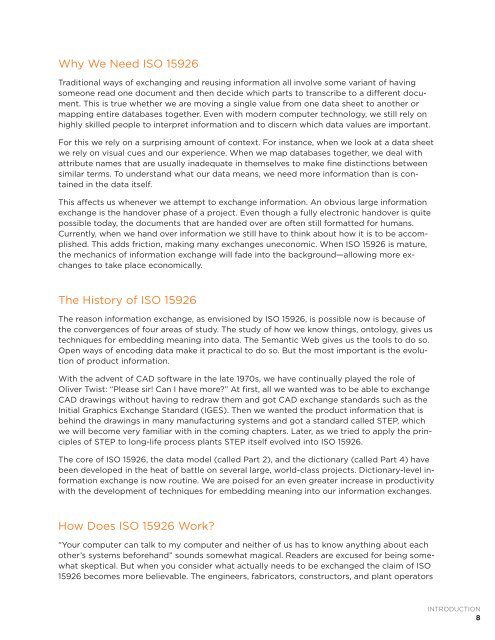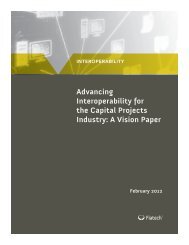An Introduction to ISO 15926 November 2011 - iRINGToday
An Introduction to ISO 15926 November 2011 - iRINGToday
An Introduction to ISO 15926 November 2011 - iRINGToday
You also want an ePaper? Increase the reach of your titles
YUMPU automatically turns print PDFs into web optimized ePapers that Google loves.
Why We Need <strong>ISO</strong> <strong>15926</strong><br />
Traditional ways of exchanging and reusing information all involve some variant of having<br />
someone read one document and then decide which parts <strong>to</strong> transcribe <strong>to</strong> a different document.<br />
This is true whether we are moving a single value from one data sheet <strong>to</strong> another or<br />
mapping entire databases <strong>to</strong>gether. Even with modern computer technology, we still rely on<br />
highly skilled people <strong>to</strong> interpret information and <strong>to</strong> discern which data values are important.<br />
For this we rely on a surprising amount of context. For instance, when we look at a data sheet<br />
we rely on visual cues and our experience. When we map databases <strong>to</strong>gether, we deal with<br />
attribute names that are usually inadequate in themselves <strong>to</strong> make fine distinctions between<br />
similar terms. To understand what our data means, we need more information than is contained<br />
in the data itself.<br />
This affects us whenever we attempt <strong>to</strong> exchange information. <strong>An</strong> obvious large information<br />
exchange is the handover phase of a project. Even though a fully electronic handover is quite<br />
possible <strong>to</strong>day, the documents that are handed over are often still formatted for humans.<br />
Currently, when we hand over information we still have <strong>to</strong> think about how it is <strong>to</strong> be accomplished.<br />
This adds friction, making many exchanges uneconomic. When <strong>ISO</strong> <strong>15926</strong> is mature,<br />
the mechanics of information exchange will fade in<strong>to</strong> the background—allowing more exchanges<br />
<strong>to</strong> take place economically.<br />
The His<strong>to</strong>ry of <strong>ISO</strong> <strong>15926</strong><br />
The reason information exchange, as envisioned by <strong>ISO</strong> <strong>15926</strong>, is possible now is because of<br />
the convergences of four areas of study. The study of how we know things, on<strong>to</strong>logy, gives us<br />
techniques for embedding meaning in<strong>to</strong> data. The Semantic Web gives us the <strong>to</strong>ols <strong>to</strong> do so.<br />
Open ways of encoding data make it practical <strong>to</strong> do so. But the most important is the evolution<br />
of product information.<br />
With the advent of CAD software in the late 1970s, we have continually played the role of<br />
Oliver Twist: “Please sir! Can I have more?” At first, all we wanted was <strong>to</strong> be able <strong>to</strong> exchange<br />
CAD drawings without having <strong>to</strong> redraw them and got CAD exchange standards such as the<br />
Initial Graphics Exchange Standard (IGES). Then we wanted the product information that is<br />
behind the drawings in many manufacturing systems and got a standard called STEP, which<br />
we will become very familiar with in the coming chapters. Later, as we tried <strong>to</strong> apply the principles<br />
of STEP <strong>to</strong> long-life process plants STEP itself evolved in<strong>to</strong> <strong>ISO</strong> <strong>15926</strong>.<br />
The core of <strong>ISO</strong> <strong>15926</strong>, the data model (called Part 2), and the dictionary (called Part 4) have<br />
been developed in the heat of battle on several large, world-class projects. Dictionary-level information<br />
exchange is now routine. We are poised for an even greater increase in productivity<br />
with the development of techniques for embedding meaning in<strong>to</strong> our information exchanges.<br />
How Does <strong>ISO</strong> <strong>15926</strong> Work?<br />
“Your computer can talk <strong>to</strong> my computer and neither of us has <strong>to</strong> know anything about each<br />
other’s systems beforehand” sounds somewhat magical. Readers are excused for being somewhat<br />
skeptical. But when you consider what actually needs <strong>to</strong> be exchanged the claim of <strong>ISO</strong><br />
<strong>15926</strong> becomes more believable. The engineers, fabrica<strong>to</strong>rs, construc<strong>to</strong>rs, and plant opera<strong>to</strong>rs<br />
INTRODUCTION<br />
8



